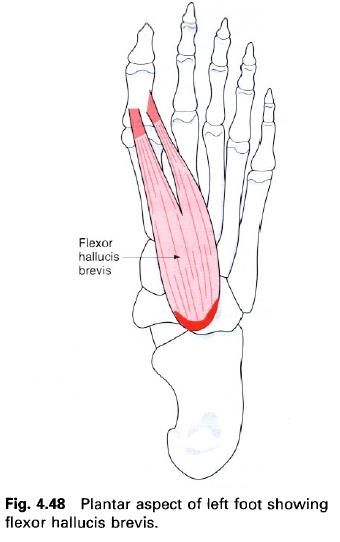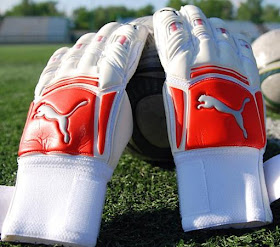Flexor accessorius (quadratus plantae)
Flexor digitorum brevis
Flexor hallucis brevis
Flexor accessorius (quadratus plantae)
Flexor accessorius lies deep to flexor
digitorum brevis, arising by two heads from the medial and lateral tubercles of the calcaneus and the adjacent long plantar ligament. A flattened
muscular band is formed by the merging of the two heads which inserts into the tendon of flexor digitorum longus in the midpoint of the sole, proximal to
the origin of the lumbricals.
Nerve
supply
Flexor accessorius is supplied by the lateral plantar nerve, root value S2, 3.
The skin over the region is supplied by root S1.
Action
It helps the long flexor tendons flex all the
joints of the lateral four toes. By pulling on the lateral side of the tendon
of flexor digitorum longus, it
changes the direction of pull so that the toes flex towards the heel and not
towards the medial malleolus.
Functional
activity
Flexor accessorius has an important role to
play in gait when flexor digitorum longus
is already shortened because of plantarflexion of the ankle joint. This muscle
exerts its action on the long flexor tendons so that the toes can be flexed to
grip the ground giving support and thrust during the propulsive phase. This
action essentially means that flexor digitorum longus can be considered to act powerfully across two joints at
the same time – an unusual phenomenon.
Palpation
Lying deep in the sole of the foot, flexor accessorius cannot be palpated.
Flexor digitorum brevis
Flexor digitorum brevis is situated in the sole
of the foot lying just deep to the
central part of the plantar aponeurosis between abductor hallucis medially and
abductor digiti minimi laterally. Arising from the medial tubercle of the calcaneus,
the deep surface of the central portion of the plantar aponeurosis and the
muscular septa either side, the fibres pass forwards in the middle of the sole,
and separate into four tendons, which pass to the lateral four toes. Just
distal to the metatarsophalangeal joint, within their respective fibrous flexor
sheaths, each tendon splits into two for the passage of the flexor digitorum longus tendon, which
passes from deep to superficial. After rotating through almost 180° the outer
margins of the slips of each tendon rejoin, leaving a shallow groove along
which the flexor digitorum longus
tendon slides. After passing over the proximal interphalangeal joint, the tendon
again splits to insert into the sides
of the base of the middle phalanx.
Nerve
supply
Flexor digitorum brevis is supplied by the medial plantar nerve, root value S2, 3.
The skin covering this area is supplied by roots L5, S1.
Action
Flexor digitorum brevis primarily flexes the
proximal interphalangeal joint of the lateral four toes, followed by flexion of
the metatarsophalangeal joints.
Functional
activity
Flexor digitorum brevis is obviously concerned,
as is flexor digitorum longus, in
producing the thrust from the toes when the demand arises.
Palpation
This muscle is almost impossible to palpate as
it is covered with some of the thickest fascia in the body and its tendons lie
deep within the foot.
Flexor hallucis brevis
Flexor hallucis brevis is a short muscle
situated deep in the sole of the foot,
appearing between abductor hallucis medially and flexor digitorum brevis
laterally. It arises from the medial side
of the plantar surface of the cuboid bone, behind the groove for peroneus longus, and the adjacent surface of the lateral cuneiform and from the tendon of
tibialis posterior.
The muscle fibres run forwards and medially
towards the great toe, separating into two fleshy bellies to lie either side
and deep to the tendon of flexor hallucis longus. From each belly arises a
tendon which inserts onto the appropriate side of the base of the proximal
phalanx. The medial tendon unites with that of abductor hallucis, while the
lateral tendon unites with the tendon of adductor hallucis, thereby giving common
insertions. Small sesamoid bones, which run in shallow grooves on the head of
the first metatarsal, develop in each tendon.
Nerve
supply
Flexor hallucis brevis is supplied by the medial plantar nerve, root value S1, 2.
The skin covering the area is supplied by root L5.
Action
The action of flexor hallucis brevis is to flex
the metatarsophalangeal joint of the great toe.
Functional
activity
Flexor hallucis brevis will, of course, aid flexor hallucis longus in the final
push-off from the ground during activity. Being accompanied at its insertion by
abductor and adductor hallucis suggests that the steadying of the great toe
during propulsion must be of great importance, probably to ensure the
generation of maximum force. When the great toe is deformed as in hallux
valgus, where the tip points laterally and the base medially, this thrust is
lost and the patient finds it difficult to run or sometimes walk, even at slow
speeds.
It is interesting to note that it is not
uncommon for injuries to occur to the sesamoid bones, particularly in
individuals who put considerable strain on the great toe. Such injuries produce
an inflamed region where the sesamoid bone slides against the metatarsal. This
can cause considerable pain and altered function.
Palpation
This muscle is set so deep in the plantar
surface of the foot that it is not
possible to palpate. Only the sesamoid bones found within its tendons can be
felt, and then only with considerable practice.










